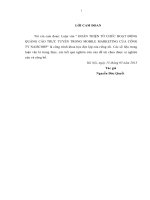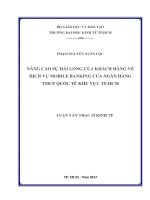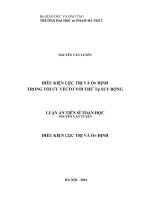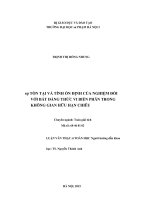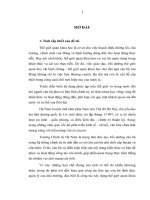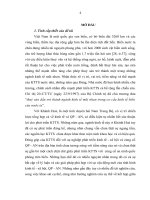(Luận văn thạc sĩ) the impact of corporate culture on sticking of employees at gtel mobile JSC
Bạn đang xem bản rút gọn của tài liệu. Xem và tải ngay bản đầy đủ của tài liệu tại đây (2.59 MB, 107 trang )
ĐẠI HỌC QUỐC GIA HÀ NỘI
KHOA QUẢN TRỊ VÀ KINH DOANH
---------------------
LÊ CẢNH DUY
THE IMPACT OF CORPORATE CULTURE ON STICKING
OF EMPLOYEES AT GTEL MOBILE JSC
ẢNH HƯỞNG CỦA VĂN HÓA DOANH NGHIỆP ĐẾN SỰ CAM KẾT
GẮN BĨ CỦA NHÂN VIÊN TẠI CƠNG TY CỔ PHẦN VIỄN THƠNG
DI ĐỘNG TỒN CẦU (GTEL MOBILE)
LUẬN VĂN THẠC SĨ QUẢN TRỊ KINH DOANH
HÀ NỘI - 2018
ĐẠI HỌC QUỐC GIA HÀ NỘI
KHOA QUẢN TRỊ VÀ KINH DOANH
---------------------
LÊ CẢNH DUY
THE IMPACT OF CORPORATE CULTURE ON STICKING
OF EMPLOYEES AT GTEL MOBILE JSC
ẢNH HƯỞNG CỦA VĂN HÓA DOANH NGHIỆP ĐẾN SỰ CAM KẾT
GẮN BĨ CỦA NHÂN VIÊN TẠI CƠNG TY CỔ PHẦN VIỄN THƠNG
DI ĐỘNG TỒN CẦU (GTEL MOBILE)
Chun ngành: Quản trị kinh doanh
Mã số: 60 34 01 02
LUẬN VĂN THẠC SĨ QUẢN TRỊ KINH DOANH
NGƯỜI HƯỚNG DẪN KHOA HỌC: TS. TRẦN KIM HÀO
Hà Nội - 2018
DECLARATION
The author confirms that the research outcome in the thesis is the result of
author‟s independent work during study and research period and it is not yet
published in other‟s research and article.
The other‟s research result and documentation (extraction, table, figure,
formula,
and other document) used in the thesis are cited properly and the
permission (if required) is given.
The author is responsible in front of the Thesis Assessment Committee,
Hanoi School of Business and Management, and the laws for above-mentioned
declaration.
Date ..…./01/2018
TABLE OF CONTENTS
LIST OF TABLES ................................................................................................................ i
LIST OF FIGURES AND CHARTS.................................................................................. ii
INTRODUCTION................................................................................................................ 1
1. Rationale ............................................................................................................. 1
2. Research overview .............................................................................................. 2
3. Research objectives............................................................................................. 5
3.1 General objective ......................................................................................... 5
3.2 Specific objectives ........................................................................................ 5
4. Research object ................................................................................................... 5
5. Research scope .................................................................................................... 5
6. Research methods ............................................................................................... 5
6.1 Preliminary research .................................................................................... 5
6.2 Formal research ........................................................................................... 6
7. Organization of the thesis ................................................................................... 6
CHAPTER
1:
THEORETICAL
FRAMEWORK
ON
ORGANIZATIONAL
CULTURE AND INFLUENCE OF ORGANIZATIONAL CULTURE ON
EMPLOYEE COMMITMENT .......................................................................................... 8
1.1 Overview of organizational culture .................................................................. 8
1.1.1 Basic concepts ........................................................................................... 8
1.1.2 Levels of organizational culture .............................................................. 10
1.2 Concepts of organizational commitment ........................................................ 14
1.3Relationship between organizational culture and employee commitment ...... 16
1.4 Previous studies on relationship between organizational culture and employee
commitment and research model of the thesis ...................................................... 17
1.4.1 Some previous studies ............................................................................. 17
1.4.2 Research model of the study .................................................................... 22
CHAPTER 2: RELAITY OF INFLUENCE OF ORGANIZATIONAL CULTURE
ON EMPLOYEE COMMITMENT AT GTEL MOBILE.............................................. 27
2.1 Overview of Gtel Mobile ................................................................................ 27
2.1.1 History of foundation and development .................................................. 27
2.1.2 Organizational structure ......................................................................... 29
2.1.3 Business operations at Gtel Mobile......................................................... 31
2.1.4 Factors affecting organizational culture atGtel Mobile ......................... 33
2.2 Results of influence of organizational culture on employee commitment ..... 39
2.2.1 Characteristics of respondents ................................................................ 40
2.2.2 Analysis of respondents’ assessments ..................................................... 42
2.2.3 Testing survey data .................................................................................. 53
2.2.4 Exploratory factor analysis (EFA) .......................................................... 55
2.2.5 Regression analysis ................................................................................. 57
2.2.6 Difference between personal characteristics and employee commitment58
2.2.7 Testing research hypotheses .................................................................... 61
2.3 Assessment of research results ....................................................................... 63
2.3.1 Achievements ........................................................................................... 63
2.3.2 Limitations and causes ............................................................................ 63
CHAPTER 3: SOLUTIONS TO IMPROVE ORGANIZATIONAL CULTURE AT
GTEL MOBILE TO ENHANCE EMPLOYEE COMMITMENT ............................... 65
3.1 Development orientation of GtelMobile ......................................................... 65
3.1.1 Opportunities and challenges for Gtel Mobile: ...................................... 65
3.1.2 Development objectives of Gtel Mobile .................................................. 66
3.1.3 Orientation and development goals for organizational culture at the company. 67
3.2 Solutions to improve organizational culture to enhance employee
commitment to Gtel .............................................................................................. 68
3.2.1 Solution for communication within the organization .............................. 68
3.2.2 Solutions for training and development .................................................. 68
3.2.3 Solutions for reward and recognition ..................................................... 69
3.2.4 Solution for efficiency in decision making .............................................. 70
3.2.5 Solution for innovation and risk acceptance ........................................... 70
3.2.6 Solution for future plan orientation......................................................... 71
3.2.7 Solution for teamwork ............................................................................. 71
3.2.8 Solutions for fairness and consistency in management policies ............. 72
3.3 Limitations and further research orientation................................................... 72
CONCLUSION .................................................................................................................. 74
REFERENCES ................................................................................................................... 75
APPENDIX......................................................................................................................... 77
LIST OF TABLES
Table 2.1: Business Activity result of Gtel Mobile .......................................................... 31
Table 2.2 Annual rituals, festivals ..................................................................................... 35
Table 2.3 Characteristics of respondents .......................................................................... 41
Table 2.4 Communication within the organization .......................................................... 43
Table 2.5 Training and development................................................................................. 44
Table 2.6 Reward and recognition .................................................................................... 45
Table 2.7 Efficiency in decision making .......................................................................... 46
Table 2.8 Innovation and risk acceptance ......................................................................... 48
Table 2.9 Future plan orientation ...................................................................................... 49
Table 2.10 Teamwork ........................................................................................................ 50
Table 2.11 Fairness and consistency in management policies ........................................ 51
Table 2.12 Employee commitment to the organization ................................................... 52
Table 2.13 Reliability of the scale ..................................................................................... 53
Table 2.14 Results of EFA with variables in the model .................................................. 55
Table 2.15 Results of regression analysis ......................................................................... 57
Table 2.16 Difference in terms of gender ......................................................................... 58
Table 2.17 Difference in terms of age ............................................................................... 59
Table2.18 Difference in terms of education level ............................................................ 60
Table2.19 Difference in terms of income ......................................................................... 60
Table2.20 Difference in terms of working experience..................................................... 61
Table2.21 Results of testing researchhypotheses ............................................................. 62
i
LIST OF FIGURES AND CHARTS
Figure 1.1: Levels of organizational culture ..................................................................... 11
Figure 1.2: Iceberg of organizational culture .................................................................... 12
Figure 1.3: Structure of organizational culture ................................................................. 13
Figure 1.4: Model of ZeinabInanlou&Ji-Young Ahn (2016) .......................................... 18
Figure 1.5: Research model of ZahariahMohdZain et al. (2009) .................................... 19
Figure 1.6: Research model of Nguyen ThiThuy Duong et al. (2015) ........................... 20
Figure 1.7: Researh model of Vu Dang QuocAnh (2013) ............................................... 22
Figure 1.8: Proposed research model in the study............................................................ 24
Figure 2.1: Organizational structure of Gtel Mobile ........................................................ 30
Figure2.2: Research procedure .......................................................................................... 40
ii
INTRODUCTION
1. Rationale
Organizational culture is the content is becoming more and more important to
the business community in Vietnam in general, and start-up businesses community,
in particular. This factor has gradually become an indispensable content of the
development strategies of all businesses. In most enterprises (except for some of
family companies), the working environment is often quite complex and varied due
to the differences in culture, education, awareness, social relations, social status... of
employees. In addition, among the trend of globalization and international
integration, enterprises are required to continuously innovation and creativeness to
increase competitiveness and building a strong brand in the market. One of the
important factors to increase the competitiveness for enterprises that is building a
professional and stability labor force. So how to make the working environment in
enterprises become more efficient, capable of promoting the creativity of employees
to achieve the strategic objectives?
Moreover, maintaining a stable workforce, limited the situation of talent staffs
leave company is also an important task else. This is consistent with the trend of the
modern world in the “knowledge economy” nowadays. Market power is not only
based on financial strength, technology, natural resources, but also depends on the
quality of human resources. The world is now in the era of knowledge economy
(after the technology era), so, human resources and intellectual strength are
particularly important factors for any enterprises today.
In this trend, the modern management theory has also gradually changed.
Human resource no longer regarded as "factors of production" that now turn into
"an invaluable asset of the enterprise". As the results, enterprises also change their
strategy from "save labor costs to reduce production costs," into strategy of "to
invest in high-quality human resources" to take the competitive advantage. On this
perspective, enterprises need to maintain the organizational culture really suitable to
promote the value of knowledge, creativity and increase the loyalty of employees.
1
On market today, in general, most of enterprises and the start-up enterprises in the
field of information technology have its own strategy in attracting talent staffs. There are
some solutions for success in attracting talent strategies include: promoting personal
capacity, improve the working environment, create effective teams, increasing
investment in human resources, public mechanisms encourage and motivate employees...
These elements are all focused on to the overall subject that is to create a friendly and
effectively working environment, help for staff creativity, cohesion and contribute their
best for the organization. These positive factors that help improve the relationship
between employees within the enterprise, becoming the positive cultural values.
However, the temptation and the enticement of competitors makes the maintenance of
professional staff is becoming increasingly more difficult.
Therefore, the authors selected the theme "Influence of organizational culture
on employee commitment to start-up IT enterprises" to help these enterprises get
more information and propose more effective solutions in maintaining highqualified staff, thereby helping enterprises stability and development soon.
2. Research overview
Organizational culture, employees‟ commitment and employees‟ loyalty
become interesting topic to many researchers and corporate managers in few past
decades. Organizational culture is considered a modern management philosophy to
improve the efficiency of work done, improve the image and brand of the
enterprises. The previous studies have confirmed that the organizational culture to
help reduce conflicts, connect employees to make the business sustainable. Several
case studies in this field include:
Wanda Roos (2005) studied on "The relationship between employee
motivation, job satisfaction and organizational culture" in South Africa. In this
study, the author demonstrates the relationship between employee motivation, job
satisfaction and organizational culture. This study reflects the 3-ways interaction of
the central issues. However, limitations of this study in the survey sample. The
author observed 118 samples that were carried out in only one enterprise, so the
results should not have highly representative.
2
Research by the authors Truong Hoang Lam and Do ThiThanhVinh (2012) on
"The impact of organizational culture on the commitment of the employees: A case
study of FPT company". Conducting research, the authors use quantitative methods to
test the relationship between factors of organizational culture and the commitment of
staff at the FPT Information System Company (FPT-IS). The theoretical model was
developed based on research by Recardo and Jolly (1997) with eight components of
organizational culture affect commitment levels of employees such as communication
in corporate, training and development, rewards and recognition, risk-taking by
creativity and innovation, team working, orientation and future plans, fairness and
consistency in the policies of management and the effectiveness of the management
decides. The research results indicate that there are 7 factors influencing positively to
commitment of the employees in the company. However, the authors have not built
solutions help managers in the company FPT Information System maintenance and
renovation company culture consistent with the organization in each period in order to
retain employees, especially skilled workers.
Jim and Jerry PorrasCollim (1993) studied on "Organizational culture and job
satisfaction". In this study, the authors give reasons for success of some companies
in the world related to the organizational culture. The cultural concept of discipline,
adaptation ... is highly recommended authors. Research results indicate that culture
of discipline is an important element to help businesses from start-up become the
world's leading companies. However, limitation of this study is that, the authors did
not to assess the impact of the culture of discipline to the commitment and loyalty
of employees.
Another research by Mary Monica Jiony et al (2013) with the title of
"Understanding the effect of organizational culture on organizational performance
and employee engagement organizational communication using as mediator: A
conceptual framework”. The authors conducted the research model based on the
model of Recardo and Jolly (1997) and deducted four of eight factors. In this
research, these authors used four factors are: communication, teamwork, training
and development, rewards and recognition. The study results showed that the four
3
aspects of organizational culture are substantially positive impact on employees‟
commitment. However, the limitations of this study is the small sample (only 190
surveyed) and implemented on a company in Malaysia then the study results could
not be representatives for all.
Also based on the model of Recardo and Jolly (1997), the author Do
ThuyLanHuongconducted a similar study in enterprises in Ho Chi Minh City. All
eight elements of organizational culture (modeled Recardo and Jolly) is the author
LanHuong used in his research. The research results have contributed to expanding
knowledge about the influence of organizational culture to the commitment of the
staff. According to this study, there are 5 factors of organizational culture to
positively influence employee commitment include: risks-taking by creativity and
innovation (0.323), Training and Development (0.180), fairness and consistency of
management policies (0.179), Planning for the future (0.162) and Communication
in business (0.142). In addition to the research contributions mentioned above, this
study also indicates certain restrictions. The first is the small sample size limits
(202-not a guarantee for the overall representation in Ho Chi Minh). Second,
interviewees are full-time employees should not express clear relationship between
organizational culture and employee commitment in a comprehensive manner.
In 2010, the author Vu Dang QuocAnh performed a study at the Saigon Paper
Joint Stock Company. This study points out the factors of organizational culture of
Saigon Paper Corporation has influenced to the commitment of the staffs. Since
then, the author proposed solutions in order to improve the organizational culture
and improving the level of employee commitment to Saigon Paper Company.
However, this study cannot be applied widely to other enterprises, especially
enterprises in the information technology environment.
Thus, after review of the previous researches, the author finds that the
“research gaps” including: shortage of study for start-up enterprises in the IT sector
and, almost the studies has a narrow range of application due to limited sample size.
Therefore, the author expects this study will contribute significantly both in theory
and practice in addressing the urgency with start-up companies in the information
technology sector and also fill “the research gaps” pointed out.
4
3. Research objectives
3.1 General objective
The general objective of the study is to evaluate the influence of Gtel Mobile‟s
organizational culture on employee commitment.
3.2 Specific objectives
- Systemizing the theoretical framework onorganizational culture, the
relationship between organizational culture elements and employee commitment;
- Evaluating the reality and aspects of organizational culture of GTel Mobile.
- Measuring the orders of importance of organizational culture factors
affecting the employee commitment at Gtel Mobile;
- Exploring the difference in levels of commitment of employees in terms of
educational level, job position, income, age, working time, etc at Gtel Mobile;
- Proposing solutions to improve the organizational culture in order to enhance
the employee commitment and employee loyalty; creating a professional and
friendly working environment to enhace employee commitment to the company.
4. Research object
Influence of organizational culture on employee commitment to Gtel Mobile.
5. Research scope
Space: This study was carried out at Gtel Mobile.
Time: The study was conducted to find out the influence of organizational
culture on employee commitment in the stage of2013 - 2016.
6. Research methods
6.1 Preliminary research
Qualitative research will be carried out firstly through review theoretical
frameworks on corporate culture, main characteristics of start-up enterprises in IT sector.
The intended model and scales based on the Recardo and Jolly (1997) model; Truong
Hoang Lam and Do Thi Thanh Vinh (2012), Do Thuy Lan Huong (2008).
Secondary research documentary sources: will be collected from the scientific
research projects on the issue of organizational culture, corporate culture, via the
press, the internet..., the final reports, consultant reports for the startups enterprises
in the field of information technology, specialized magazines and newspapers
5
Primary data will be explored through interviews with questionnaires of
employees in the start-up enterprises in IT sector.
6.2 Formal research
- Sampling: Determining how many sample sizes are appropriate is still
controversial with many different views. According to Comrey& Lee (1992),
estimates of sample sizes are different with the corresponding estimates: 100 =
bad, 200 = good, 300 = good, 500 = very good, 1000 or better = excellent.
However, in this study, the expected sample size of n = 200 samples was
collected at Gtel Hanoi.
- Data processing method: In order to perform the statistical analysis of data
collected, SPSS software for Windows version 20.0 was used.
Analysis included:
Preliminary assessment of reliability and value of the scale using the
Cronbach alpha reliability coefficient and Exploratory Factor Analysis
(EFA) with SPSS software to assess reliability values of the scales, thereby
excluding unsatisfactory observed variables and restructuring the remaining
observed variables into appropriate measurement component, laying the
basis for modifying the research model and research hypotheses and
subsequent analysis.
Regression analysis: was used to test the theoretical model, research
hypotheses, and measure the importance of organizational culture factors on
employee commitment toGtel Mobile.
- T-Tests, ANOVA: were used to test whether there were differences in
assessment of employee commitment in terms of demographic, sociological
characteristics of the employees (gender, income, age, educationlevel, and
working experience).
7. Organization of the thesis
The thesis was divided into three chapters as follows:
Chapter 1: Theoretical framework on organizational culture and influence of
organizational culture on employee commitment.
6
Chapter 2: Reality and influence of organizational culture on employee
commitment at Gtel Mobile.
Chapter 3: Solutions to improve organizational culture to enhance the
employee commitment to the company.
7
CHAPTER 1: THEORETICAL FRAMEWORK ON ORGANIZATIONAL
CULTURE AND INFLUENCE OF ORGANIZATIONAL CULTURE ON
EMPLOYEE COMMITMENT
1.1 Overview of organizational culture
1.1.1 Basic concepts
1.1.1.1. Culture
In the natural and social life of human beings, culture exists in various forms
of consciousness.The definition of the term “culture” is not simple. There are many
different definitions of culture. This is because the concept of culture is widely used
in many fields in society with different notions.
Since 1952, two American cultural anthropologists showed that there were
over 150 different definitions of culture. But in general, the majority of scholars
considered culture as knowledge, a lifesyle, and the way people behave during the
process from birth to adulthood to become a memberof a society or an organization.
In 2002, UNESCO provided the following definition of culture: Culture should
be referred to as a set of spiritual, material, intellectual, and emotional characteristics of
a society or group and it contains, in addition to literature and art, the way of life, the
method of living, the system of values, the traditions and the faith.
With the view that culture is the spiritual foundation of society, the concept of
culture is expanded. President Ho Chi Minh wrote, "For the sake of survival as well as
the purpose of life, human beings created and invented language, scripts, ethics, law,
science, religion, literature and technology and tools for everyday activities including
dressing, eating, living, and usingmethods. All those creations and inventionsare
culture. Culture is the synthesis of all modes of living and its expression that human
beings have produced to meet their living and surviving needs".
In short, culture is a product of humanity.Culture is created and developed in
the interplay between human beings and society. But culture is involved in creating
people and maintaining social stability and order. Culture is passed from one
generation to another generation through socialization. Culture is reproduced and
8
developed in the process of social action and interaction of people. Culture is the
level of human and social development manifested in the types and forms of
organization of human life and actions as well as in the material and spiritual values
created by human beings.
1.1.1.2. Organizational culture
The concept of organizational culture is also as varied and rich as the concept
of culture. The following are some common concepts of organizational culture.
Organizational culture is a way of thinking and working that has become habitual
and traditional.It is shared more or less among all members. New members must learn
and accept at least some of these habits and traditions to get along with other members
and organizations. In that sense, organizational culture embraces a wide range of
behaviors: production methods, professional skills and technical knowledge, attitudes
towards organizational regulations, habits and behaviors in management,concerning
goals, how to conduct business,payment methods, regulations for different jobs, belief
in democratic living and mutual consultation,self-conscious rules and prohibitions.
Organizational culture is a style of belief and hope shared by members of the
organization. These beliefs and hopes generated criteria.They form a strong way of
behaviors of individuals, groups in the organization.
(Shwartz và Davis, 1981:33)
Culture is a distinct quality of an organization - it represents a unique quality
that distinguishes it from other organizations in the same field.
(Gold, 1982:571-2)
"Culture" refers to the beliefs, values, and tacit principles that form the basis
for the management of an organization as well as for the set of management actions,
both of which do portrays and reinforces these basic principles.
(Denison, 1990:2)
The above definitions reflect different understandings of organizational
culture. To further clarify this concept, the above definitions can be arranged in two
types: invisible and visible.
9
Definitions of invisible organizational culture considerorganizational culture
as the elements that contain the hidden principles that are shared, accepted by a
group of people in the organization, determine their perceptions, thinkings, and
actions with the changes of surrounding environment. (KreitnerKinicki 1998)
Definitions of visible organizational culture consider organizational culture as
a system that shares the views of the members of the organization to distinguish one
organization from another (Robbins). This system sets out the properties that reflect
the values of the organization.He gave seven basic qualities that represent the
culture of an organization:
+ Ability to implement reforms.
+ Level of confidence to express one‟s views
+ Tendency to focus on the outcome of the work rather than on the technique
or the way to achieve it.
+ Level of interest in the human factor: considering the effects of the work
results to the members of the organization
+ Tendency to work in the collective or individually
+ Level of struggle, criticism in the organization
+ Tendency to maintain the stability of the organization.
According to Robbins, these seven qualities will create a pretty complete
picture of the organization's culture. He argues that organizational culture involves
howmembers accept the organization's attributes not whether they like them or
not.Organizational culture research means evaluating theorganization based on the
above criteria.
This is a way of approaching the description. It helps us distinguish
organizational culture and job Satisfaction.
1.1.2 Levels of organizational culture
Considering levels of organizational culture will shed light on the process of
forming cultural values in each organization. According to Edgar H.Shein,
organizational culture can be divided into two levels:
10
- Interior and exterior architecture
Artifacts of the
The first level (visible)
organization
- Organizational structure, documents,
principles, etc.
- Rituals, festivals, logos, design, etc.
- Espoused values: strategies, goals,
Espoused values
business philosophy
- Regulations, principles of operation
The second level
(Invisible)
- Underlying assumptions:beliefs, values,
Underlying assumptions
thoughts,unconscious sentiments.
Figure 1.1: Levels of organizational culture
The term "level" refers to the level of perception of cultural values within an
organization, or can be said as visibility and invisibility, visuality and non-visuality
in the manifestation of those cultural values. This is a unique approach from the
phenomena to the nature of a culture, which helps us understand deeply and fully
the constituent parts of the culture.The two levels of organizational culture are
illustrated in Figure 1.1 above.
According to analysts, levels of organizational culture are modeled by the
culture iceberg (Figure 2.2). The upper part is the processes and the visible
structures of the organization. The lower part is of the iceberg is the invisible part of
the organizational culture, and the deepest part is the factor that creates the special
character of the organization.
11
Figure 1.2: Iceberg of organizational culture
1.1.2.1 The first level - artifacts of the organization
These are the processes and structures of the organization. This level
includes all phenomena and things that can be seen, heard and felt in contact such
as: architecture, layout, technology, products of the enterprise, organizational
structure, documents stipulating the operation principles of the enterprise,
rituals,festivals,logos, slogans, advertising materials of the enterprise; language,
costume, style, attitude and behavior of the members in the enterprise with each
other and with other people.
This is the level of culture that can be recognized at the first contact with the
senses, which is influenced by the nature of the business and the viewpoints of
leaders. On the other hand, the factors at this level are easy to change and only show
the surface andformsof organizational culture.
1.1.2.2 The second level (non-visual or invisible manifestations): espoused values
and underlyingassumptions
Espoused valuesare often expressed in the target, business strategy or
business philosophy of the enterprise.
Espoused values are both visible and invisible. They are visible because
people can recognize and express them clearly and accurately. However, the
12
graspand understanding of their meaning depends on the position, knowledge and
attitude of each person.So, they are invisible.
Underlying assumptions (beliefs, perceptions, thoughts and unconscious
sentiments) are implicitly recognized in the enterprise.
The underlying assumptions are common perceptions including beliefs,
perceptions, thoughts and sentiments that are implicitly recognized in the enterprise.
These are values that have been formed over a long period of time.They are
deeply ingrained in the psychology and sentiment of most members of an enterprise
and are implicitly recognized.
Common perceptions are difficult to be changed and are often maintained
from one generation to the next one. The cultural value at this level increases the
spirit of solidarity, pride and loyalty of members in an enterprise andthe basis for
thelongevity and sustainable development of the enterprise. The levels of
organizational culture can be expressed in the following diagram:
Artifacts
Espoused values
Underlying
assumptions
Figure 1.3: Structure of organizational culture
In another way of classification, it is assumed that organizational culture exists at
two levels: the surficial level consists of visual representations, which people can see,
hear, touch such as color, architecture, product, design, behavior, costume, symbol,
ritual, language, etc. The second level is the non-visual representations including
13
ideals, beliefs, nature of human relationships, attitude and methods of thinking,
influence of tradition and history of enterprise development on the members.
1.2 Concepts of employee commitment
Employee commitment holds an important place in the study of organizational
behavior. It hasbecome a concern of leaders and has been spread throughout
enterprises. Many researchers have come up with different concepts of
organizational commitment. Organizational commitment is defined as "multidimension" which involves the loyalty of employees in the organization, their
readiness to exert themselves on behalf of the organization and their desire to
maintain long-term attachmentto the organization.
Allen and Meyer (1990) defined commitment of employees to the
organization as a psychological state which demonstrated the relationship between
employees and the organization and the close linkto the employees‟ decision to stay
with the organization. A promise of an individual to the organization includes a
sense of commitment to work, loyalty, and belief in the values of the organization.
Meyer & Allen (1991) defined three components of commitment as follows:
Affective Commitment referred to the psychological commitment to the
organization.Continuance Commitment reflects the commitment based on the
perceived costs of leaving the organization.Normative Commitment referred to the
individual's responsibility to continue working for the organization.
In Mowday, Steers, & Porter (1979) commitment of employees to the
organization is defined as the power of unity of individuals with the organization
and their active participation in the organization; Employees who express a high
level of commitment to the organization will be more satisfied with their work,
rarely deny job responsibilities and leave the organization.
The research of RajendranMuthuveloo and RaduanChe Rose (2005) showed
that employee commitment important effects on the organization's results. The
higher commitment to the organization leads to greater loyalty, less job stress, and
lower possibility of leaving the organization. So,affective commitment is the loyal
attitude and trust of employees in the organization. In order to achieve the affective
14
commitment of employees, managers need to build and establish a positive
relationship between employees and the organization, and encourage employees to
value loyalty and dedication to the organization. If employees feel they are part of
the organization and proud to be members of the organization, they are more likely
to stay and develop with the organization in the long run.
Porter et al. (1974) discussed the three main components of employee
commitment as "an attachment to the organization, characterized by an intention to
remain in it; an identification with the values and goals of the organization; and a
willingness to exert extra effort on its behalf".
Porter et al. further describedaffective commitment in three elements (1) trust
in the organization, acceptance of the organization's goals and values, (2)
willingness to focus efforts on helping the organization achieve the goals (3)
maintenancethe membership of the organization. Affective commitment is the type
of commitment that most organizations want from their staff, so most researches on
the impact of human resource management aim at this type of commitment.
Normative commitment is a relatively new aspect in the organizational
commitment defined by Bolon (1993). Emotional commitment is a sense of
commitment that comes from the emotional factor, which makes the employees
themselves willing to continue working, dedicating to the organization. Employees
want to work for the company because of the interesting job, attractive working
environment, suitable trained field and friendly colleagues.
In 1982, Weiner discussed normative commitment as a generalized value of
loyalty and mission. Meyer and Allen (1991) supported this type of commitment
before Bolon‟s definition, with their definition of normative commitment as a sense
of duty. It is argued that normative commitment is natural due to the binding
relationships within the organization.
Lio (1995) concluded that employee commitmenttoan organization is
significantly correlated with their job security. Management style can affect the
level of employee commitment. Koopman (1991) studied the influence of
15
management style on employees and found that employees who support
management style also support the organization.
In other words, this concept comes from the positive effects tothe behavior
and performance of employees. Committed employee is less likely to leave the
organization for another job and more likely to work with greater efficiency
(Richard E.Stup, 2006).
1.3 Relationship between organizational culture and employee commitment
When products and services change, technology, people and management will
gradually become outdated.However, organizational culture will exist and develop
over time if organizations know how to manage their visions and common goals.
These are values that include a strong belief and a core goal that are motivational
and inspirational. It can be said that the values of organizational culture have
contributed considerably to the development of excellent organizations. This is
specifically presented through a number of studies as follows:
The research of Shinichi Hirota et al. (2007) suggested that culture and its
values increased the completion level of Japanese companies and that they gained a
competitive advantage through culture. Organizational culture is a distinct element
that creates competitive advantage.
According to Hellreigel et al. (2004), organizational culture could be viewed
as having an important influence on organizational commitment. In addition, the
authors including Bourantas & Papalexandris (1992), Chen (2005), Lytle et al
(2006), Rashid et al. (2003) had a number of researches to examine the positive
influence of organizational culture on organizational commitment.
First, organizational culture is considered to affect employee attitudes which is
related to their commitment to the organization (Bourantas & Papalexandris 1992;
Chen 2005).
Second, Lytle et al. (2006), believed that commitment is an element of
organizational culture, an invisible binder that links employees together and
between employees and the organization. An organization with a strong culture will
be the pride of the collective of employees when they are a member of them.
16
Hoftede (1993) as well as Cohen (2000) found a relationship between cultural types
with organizational commitment. When combining the culture model of Hofstede,
Meyer & Allen (1984), Rashid et al. (2003) with elments of organizational
commitment, it was found that cultural dimensions had a significant impact on
employee commitment.
Geiger (1998) also conducted a study using aspects of organizational culture
and found that cultural values influenced the escalation of organizational
commitment. Obviously, organizational culture and organizational commitment
affect the performance of an organization. Brewer (1993) conducted a study on the
influence of culture on the organization.The research showed that bureaucratic
culture often had a negative relationship with employee commitment in the
organization.
Recardo & Jolly (1997), Meyer & Allen (1991) arguedand proved that
organizational culture influences employee commitment to the organization.
According to Recardo and Jolly (1997), organizational culture is measured by eight
specific factors: (1) communication within the organization, (2) training and
development, (3) reward and recognition, (4) effectiveness of decision making, (5)
risk acceptance by creativityand innovation, (6) orientation for future plans, (7)
teamwork, and (8) fairness and consistency in policies.
1.4 Previous studies on relationship between organizational culture and
employee commitment and research model of the thesis
1.4.1 Some previous studies
1.4.1.1. Research model of ZeinabInanlou and Ji-Young Ahn (2016)
The authors of ZeinabInanlou and Ji-Young Ahn (2016) conducted a study on
" The Effect of Organizational Culture on Employee Commitment: A Mediating
Role of Human Resource Development in Korean Firms" with the aim to find out
the relationship between organizational culture with employee commitment in
enterprises in Korea. The research used survey data collected by the Korean
government in 2011. Based on the previous studies and combined with expert
survey methods, the authors developed a model of the impact of organizational
17
